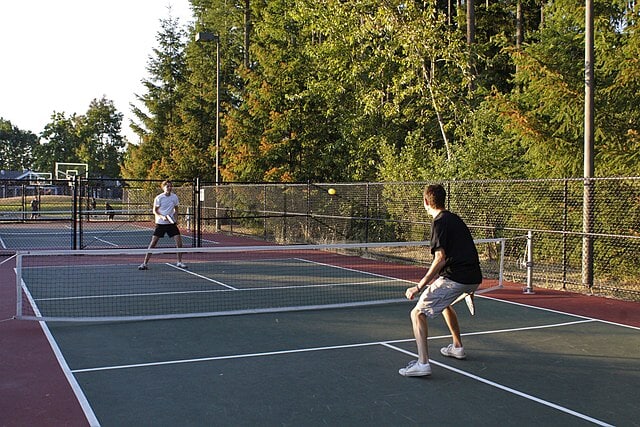
Pickleball Culture 2025: Why Everyone Is Talking About the Sport
Some cultural shifts sneak in quietly, building momentum year after year until suddenly it feels like everyone is part of it. Pickleball is the perfect example. Once dismissed as a quirky pastime, it has now taken over gyms, parks, and conversations across the country. In 2025, pickleball culture is bigger than ever. From celebrities and athletes endorsing it to entire communities redesigning spaces for it, pickleball has gone from fringe hobby to mainstream obsession. The question is not whether you have heard of it, but whether you are already playing.
A Brief History of Pickleball
Pickleball did not appear out of nowhere. It was invented in 1965 on Bainbridge Island, Washington, by a group of families looking for something fun and easy to play together. The game combined elements of tennis, badminton, and ping-pong with a smaller court and lighter paddle. For decades it remained a niche activity, popular with retirees because of its lower physical strain. But around 2020, the growth curve bent sharply upward. Courts multiplied, pro tours launched, and suddenly a sport once considered niche became a cultural juggernaut.
The Pandemic Push and Social Shift
Part of the rise came from the pandemic. Pickleball was easy to play outdoors, safe for social distancing, and simple to learn. People who had never considered racket sports suddenly gave it a try. Families picked it up together. Neighborhoods painted pickleball lines onto old tennis courts. By the time life returned to normal, the sport had already carved out a permanent place in culture.
Celebrities, Athletes, and the Pickleball Effect
Another reason pickleball exploded is the celebrity endorsement effect. Retired athletes like Tom Brady and LeBron James invested in pickleball leagues. Celebrities like Ellen DeGeneres, Leonardo DiCaprio, and Kim Kardashian were photographed playing. When famous people signal that something is cool, the culture follows. Suddenly pickleball was not just for grandparents, it was a trendy, Instagrammable hobby.
Professional pickleball leagues also added legitimacy. Tournaments drew crowds. Streaming platforms broadcast matches. Sponsorships rolled in. The more exposure the sport got, the faster it grew. By 2025, pickleball has reached a cultural tipping point where it is no longer an alternative to tennis, it is a phenomenon in its own right.
Generational Appeal Across the Board
Pickleball’s secret weapon is its universal accessibility. Teenagers play it for fun, retirees play it for fitness, and everyone in between finds something appealing about it. The smaller court means less running than tennis. The paddle and ball are easier to control. Games move quickly but rarely feel overwhelming. It strikes the balance between competition and playfulness.
For Gen Z, pickleball fits the social media vibe perfectly. It is easy to film, easy to share, and filled with funny rallies that look great on TikTok. For Millennials, it is a low-cost, social alternative to expensive gyms or team sports that require scheduling. For Boomers, it is a way to stay active without overexerting joints. Rarely does one sport check so many boxes at once.
Community and the Culture of Belonging
Perhaps the biggest factor driving pickleball culture in 2025 is community. Courts have become social hubs. Neighborhoods organize leagues and mixers. Parks host open play sessions where strangers become friends. Pickleball is less about who wins and more about who shows up. The sport thrives on inclusivity. You do not need years of training to enjoy it. You can join a game within minutes, regardless of skill level.
This culture of belonging makes pickleball more than just exercise. It is a lifestyle. People wear pickleball-themed shirts, hats, and sneakers. They share memes about the sport. They organize trips around tournaments. Like skateboarding in the 90s or yoga in the 2000s, pickleball is no longer just an activity, it is an identity.
The Economics of Pickleball
Growth brings money. Entire industries have sprung up around pickleball. Paddle companies compete with high-tech materials and flashy designs. Apparel brands sponsor pro players. Restaurants near courts host pickleball happy hours. Real estate developers now include pickleball courts in luxury apartment complexes, knowing it will attract tenants.
Municipalities are investing too. Cities convert unused tennis courts into pickleball courts. Recreation centers hold pickleball nights. The sport is shaping not just culture but also urban design and local economies.
Why Pickleball Fits 2025
Pickleball is a sport made for the current cultural moment. People want activities that are social, accessible, and easy to share online. They want fitness without intimidation. They want hobbies that connect generations rather than separate them. Pickleball checks every one of those boxes.
It is also low-cost compared to many other activities. A paddle and ball are relatively inexpensive, and courts are often free or cheap to access. In a time when many people feel financially stretched, pickleball feels approachable.
Pickleball has fully entered the pop culture arena. TV shows reference it in jokes. Brands sponsor pickleball influencers. Memes circulate showing how intense casual games can get. The sport is no longer niche; it is part of everyday cultural conversation. When late-night hosts riff on pickleball, when sitcoms include it in scripts, and when TikTok trends revolve around it, you know it has crossed into the mainstream.
Looking Ahead: What’s Next for Pickleball
Where does pickleball go from here? The possibilities are wide open. Pro leagues will likely grow, with more broadcast deals and bigger sponsorships. Tech companies may introduce tracking apps that log swings and rallies. International tournaments could expand the sport globally. Pickleball may follow the trajectory of skateboarding, starting as a niche, exploding into culture, and then becoming a permanent fixture in the athletic landscape.
At the community level, expect pickleball to continue anchoring social life. More local bars and restaurants may integrate courts. Parks will build new spaces dedicated to it. Schools may adopt it into PE classes. Within a few years, calling pickleball a fad will feel outdated.
Pickleball culture in 2025 is about more than a game. It is about how people connect, move, and share joy. It represents a cultural shift toward activities that blend fitness with fun, accessibility with community, and tradition with modern hype. Whether you have already picked up a paddle or are just now hearing friends talk about it, pickleball is not going away. It is here to stay, and its story is still unfolding.
What began as a family invention on Bainbridge Island is now a global trend redefining how people come together. In 2025, pickleball is not just a sport. It is a symbol of a culture that values fun, inclusivity, and connection above all else.




